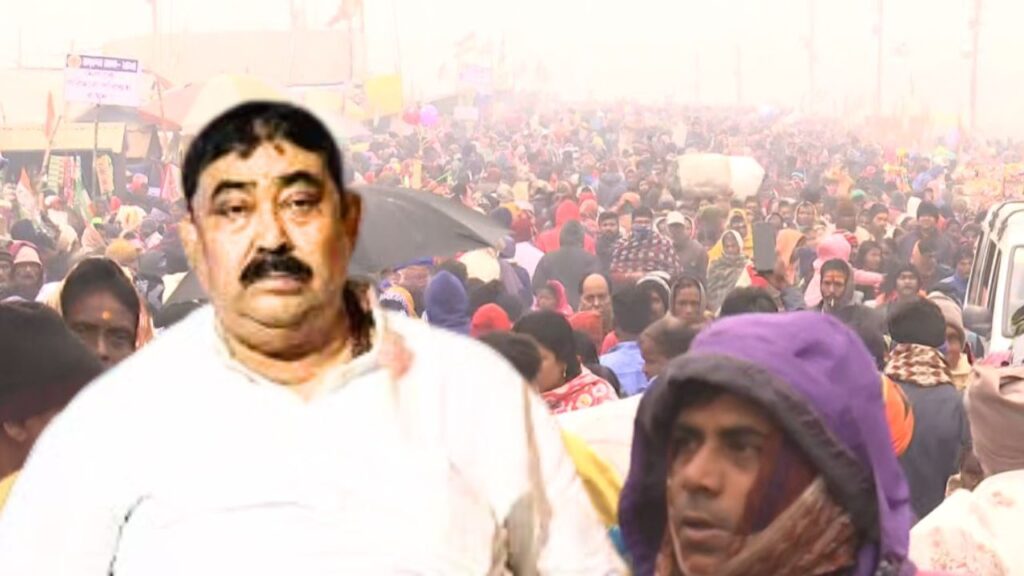NIN365 Desk, Kolkata : Anubrat Mandal: A Controversial Figure Amidst Celebrations in Tihar Jail ;
Anubrat Mandal, a prominent political figure, has found himself entangled in controversy and celebration within the confines of Tihar Jail for over a year. The district president post has been stripped from his name, and allegations of tearing his banners have surfaced multiple times, with Trinamool leader Kajal Sheikh claiming that Anubrat’s posters are being unveiled in her stronghold. Amidst these events, Anubrat’s ‘homecoming’ is being observed at the Joydev Fair, even as he remains incarcerated.
The Joydev Fair, known for its vibrant political presence, is witnessing the paradoxical celebration of Anubrat Mandal’s influence. Despite not being physically present, his images prominently feature on stalls and gates throughout the fair. This peculiar scenario raises questions about the dynamics of local politics, the influence of incarcerated leaders, and the intersection of controversy and celebration.
Kajal Sheikh, a prominent Trinamool leader, alleges that Anubrat’s posters are being displayed in her stronghold, intensifying the political rivalry. The removal of Anubrat from the district president post has not quelled the political fervor surrounding him. His ‘homecoming’ at the Joydev Fair, symbolized by the widespread display of his images, adds a layer of intrigue to the ongoing political dynamics in the region.
Gautam Ghosh, the editor of CPM’s Birbhum district, acknowledges the inevitable presence of politics in gatherings of people. He emphasizes that while politics is not uncomfortable in such settings, the influence of Abhishek Banerjee and Mamata Banerjee’s struggle resonates through the district. Ghosh’s perspective offers insight into the broader political landscape, where the political narratives of different parties intersect, even within the confines of Tihar Jail.
Shyamapada Mandal, the state vice-president of BJP, highlights the divisive nature of Trinamool Congress, accusing them of spreading division everywhere. He notes that despite the holy nature of the Joydev Fair, it has not been spared from political intrusion. Mandal’s remarks underscore the complexity of political engagements in spaces traditionally considered sacred, raising questions about the ethical dimensions of political campaigning.
Maloy Mukhopadhyay, the vice-president of Trinamool Congress in Birbhum district, provides clarity on the party’s stance, stating that there is no directive regarding the display of Anubrat Mandal’s banners. He categorically mentions that the presence of Anubrat’s images at the Joydev Fair is not a party program. Mukhopadhyay’s statement reflects the internal dynamics within political parties and the nuanced relationship between leaders and the party’s official stance.
In the midst of controversy and celebration, Anubrat Mandal’s images continue to play a significant role in shaping the political narrative. The paradox of his ‘homecoming’ within Tihar Jail raises questions about the nature of political influence and the public’s perception of incarcerated leaders. As the Joydev Fair becomes a canvas for political expressions, the images of Anubrat Mandal contribute to the broader discourse on the intertwining of politics, controversy, and celebration in contemporary Indian politics.
In conclusion, Anubrat Mandal’s presence in the political landscape, even within the confines of Tihar Jail, adds a layer of complexity to the ongoing political dynamics. The Joydev Fair serves as a microcosm reflecting the intricate intersections of political narratives, rivalries, and public sentiments. The controversy surrounding Anubrat’s banners and the celebration of his influence underscore the multifaceted nature of politics, where perceptions and realities often diverge.
DISCLAIMER
Our news media denounces any form of bias and disapproves of sensationalism. The disseminated news is entirely educational and aimed at social awareness. Our media maintains absolute impartiality, adhering solely to the purpose of education and social consciousness.


